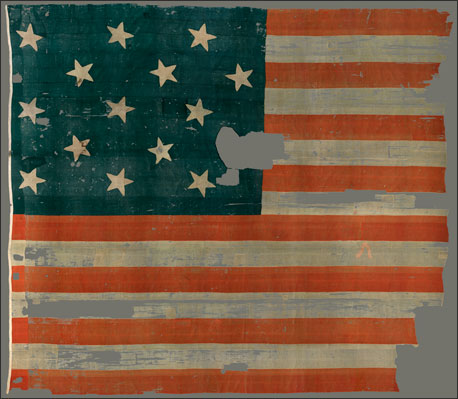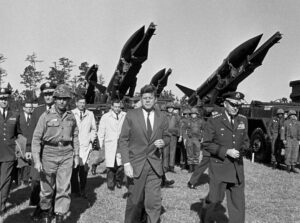Francis Scott Key was born on August 1, 1779 in Terra Rubra, Maryland. After graduating college, Key began to study law in hopes of becoming an attorney.1 Soon after, Keys got married and had eleven children and moved to Georgetown where he started his own practice.2 Key became very successful in his work as a lawyer, and for hobbies he sang for the church and wrote poems, a lot of which are still appreciated today. When the War of 1812 broke out, Key enlisted in the US army.3

Francis Scott Key was sent to a British ship to negotiate the release of certain prisoners. Upon Key’s arrival to the ship, he showed the Commodore of the ship letters from British troops that had been captured by American forces.4 The letters explained how well they were being treated and that they were not harmed in any way. After seeing this, the Commodore let their prisoner William Beanes free, but before the three American men could leave, the British troops were preparing to attack Fort McHenry, and therefore needed to keep them on the ship so that they would not be able to return back to warn the American troops.5
For over twenty-four hours the two sides, American and British, exchanged fire. The British recorded that “over eight hundred shells” were shot at the fort.6 After twenty-four hours of fighting both on land and sea, Francis Scott Key waited for the smoke to clear and saw that the American flag at Fort McHenry was still waving high. Key immediately began to write a poem on what he had witnessed that day. The poem quickly rose to fame and gained the attention of almost every single American.7
Very few people know that the poem went through different phases before becoming the American National Anthem. The original title of the poem was “The Defense of Fort McHenry.” Key later added the tune from an old drinking song called “To Anacreon in Heaven.”8 Later, Congress met to decide on a song for the nation; all songs were rejected, including “The Defense on Fort McHenry.” People that opposed the song claimed that the lyrics were too difficult to sing, it was not martial enough, and it was only about one event in all of American history.9 People who supported the song loved that the lyrics were difficult; that way only professional musicians and singers could sing it before certain important occasions.10
It was not until 1916 that the United States made the “The Star-Spangled Banner” the unofficial nation anthem. Woodrow Wilson was asked to have a “ceremonial song” for the United States, so he picked the most loved song by the people of the United States.11 But it was not until 1931 that Congress adopted the “The Star-Spangled Banner” as the official nation anthem of America. The poem was seen and adored by Americans for the patriotism it stood for and as a reminder of its past victories. This song is now sung before almost every major event in the United States to serve as a reminder of America’s victory against all odds.12
While the first stanza of the poem is widely known and sung today, few have been able to appreciate it in its entirety. Here, then, is the original poem:
O say can you see, by the dawn’s early light,
What so proudly we hail’d at the twilight’s last gleaming,
Whose broad stripes and bright stars through the perilous fight
O’er the ramparts we watch’d were so gallantly streaming?
And the rocket’s red glare, the bomb bursting in air,
Gave proof through the night that our flag was still there,
O say does that star-spangled banner yet wave
O’er the land of the free and the home of the brave?
On the shore dimly seen through the mists of the deep
Where the foe’s haughty host in dread silence reposes,
What is that which the breeze, o’er the towering steep,
As it fitfully blows, half conceals, half discloses?
Now it catches the gleam of the morning’s first beam,
In full glory reflected now shines in the stream,
‘Tis the star-spangled banner – O long may it wave
O’er the land of the free and the home of the brave!
And where is that band who so vauntingly swore,
That the havoc of war and the battle’s confusion
A home and a Country should leave us no more?
Their blood has wash’d out their foul footstep’s pollution.
No refuge could save the hireling and slave
From the terror of flight or the gloom of the grave,
And the star-spangled banner in triumph doth wave
O’er the land of the free and the home of the brave.
O thus be it ever when freemen shall stand
Between their lov’d home and the war’s desolation!
Blest with vict’ry and peace may the heav’n rescued land
Praise the power that hath made and preserv’d us a nation!
Then conquer we must, when our cause it is just,
And this be our motto – “In God is our trust,”
And the star-spangled banner in triumph shall wave
O’er the land of the free and the home of the brave.13
- War of 1812, 2002, s.v. “Key, Francis Scott.” ↵
- War of 1812, 2002, s.v. “Key, Francis Scott.” ↵
- War of 1812, 2002, s.v. “Key, Francis Scott.” ↵
- War of 1812, 2002, s.v. “Key, Francis Scott.” ↵
- UXL Encyclopedia of U.S. History, 2009, s.v. “The Star-Spangled Banner,” by Sonia Benson, Daniel E. Brannen, Jr., and Rebecca Valentine. ↵
- UXL Encyclopedia of U.S. History, 2009, s.v. “The Star-Spangled Banner,” by Sonia Benson, Daniel E. Brannen, Jr., and Rebecca Valentine. ↵
- UXL Encyclopedia of U.S. History, 2009, s.v. “The Star-Spangled Banner,” by Sonia Benson, Daniel E. Brannen, Jr., and Rebecca Valentine. ↵
- “Key, Francis Scott,” in Shaping of America, 1783-1815 Reference Library, edited by Lawrence W. Baker, Richard C. Hanes, Sharon M. Hanes, and Kelly Rudd, Vol. 2, Biographies Volume 1, 257. ↵
- “Key, Francis Scott,” in Shaping of America, 1783-1815 Reference Library, edited by Lawrence W. Baker, Richard C. Hanes, Sharon M. Hanes, and Kelly Rudd, Vol. 2, Biographies Volume 1, 258. ↵
- “Key, Francis Scott.” In Shaping of America, 1783-1815 Reference Library, edited by Lawrence W. Baker, Richard C. Hanes, Sharon M. Hanes, and Kelly Rudd, . Vol. 2, Biographies Volume 1,258. ↵
- “Key, Francis Scott.” In Shaping of America, 1783-1815 Reference Library, edited by Lawrence W. Baker, Richard C. Hanes, Sharon M. Hanes, and Kelly Rudd, Vol. 2, Biographies Volume 1,258. ↵
- UXL Encyclopedia of U.S. History, 2009 s.v. “The Star-Spangled Banner,” by Benson, Sonia, Daniel E. Brannen, Jr., and Rebecca Valentine. ↵
- Francis Scott Key, “The Star-Spangled Banner” (wording of the original handwritten manuscript, in the Museum Department of the Maryland Historical Society). ↵



101 comments
Rahni Hingoranee
I am a very patriotic American so this article had immediate appeal to me. Learning that Francis Scott Key was a part of the war against the British makes a lot of sense because of the lyrics of the Star-Spangled Banner. I liked learning about the history behind the song and the author made the article well laid out. I did not know the inspiration Key had was from the battle of Fort McHenry.
Amanda Uribe
I learned a lot from this article. I knew that the national anthem was written after the battle in 1812, but I did not know that he was on the british ship to negotiate when he was himself, held capture. I found it interesting that he was a lawyer. I also found it interesting how they declined his song as the national anthem. I had no idea that the name was changed! This article was very informitive and I am glad I found it.
Matthew Swaykus
This article was interesting. I knew that the story of how The Star-Spangled Banner was written after the assault on Fort McHenry, but I never knew how long it took for the song to be recognized as the official National Anthem. I honestly cannot believe that I will get to see, in 2031, the 100th year anniversary of the song being recognized by every nation as the official ode to the United States.
Christopher Hohman
Nice article. The Star Spangled Banner is a very important song to American history. However, it did not always hold the important place that it does now. It took well over one hundred years for the song to become the official national anthem. I did not know that before, I had always assumed that it was adopted right after it was written but I was wrong. There is also more to the song than I realized which is cool.
Andrew Petri
This article is very interesting because it is something that I have known all my life, but never known how it came about. Knowing that the anthem came from a poem is an interesting origin. Especially because it did not start out as our national anthem, but went through a series of stages over a very long period of time. This information is something that, though I did not know, is very influential of my life today.
Engelbert Madrid
Before reading this article, I did not know that the Star Spangled Banner, which was originally named as “The Defense of Fort McHenry” was a poem written by Francis Scott Key, who was in a ship that was under attacked by another ship. In this poem, he showed his gratitude and love for the American flag and the country as well. No wonder this poem, that is now known as the Star Spangled Banner, became the national anthem of the United States of America.
Vanessa Sanchez
I like how this article brings out the way the anthem was made. It helps other people know how and who created this. It was originally a poem. The article showed that as Frances was waiting the air to clear up due to all the gunshots, he saw that the flag was still standing. With that, it inspired him to write the poem which became a huge hit. Overall, it was an amazing article to read as it show the history of our Anthem.
Cameron Lopez
I remember learning about the Star Spangled banner in school and I am a patriot, I love my country. For it being the very early stages of music back in 1700’s he wrote an absolute memorial song that has the meaning of our beloved country. Reading this article brought back certain aspects that I forgot or didn’t know all together as a matter of fact. It was a great article how it was written and presented. Its amazing to learn the history behind it and understand its true meaning to this great country.
Joshua Garza
This is an amazing story and written in our own national anthem is the image of the blood that was shed to make America the big super power that it is today in the world. Our National anthem is not just symbolic and cleverly put together by a writer that was good with words and was higher-ed to write something. This is a mans experience in battle for his country. That’s amazing.
Indhira Mata
I never knew that the National Anthem went through different phases before becoming what it is today. I remember how in elementary this was one of the first things they taught us and would put it on every morning. Before reading this article I just assumed it was written just how we sing it, but it is nice to learn about the truth behind it. I think everyone should read this article and fulling learn about the Anthem.